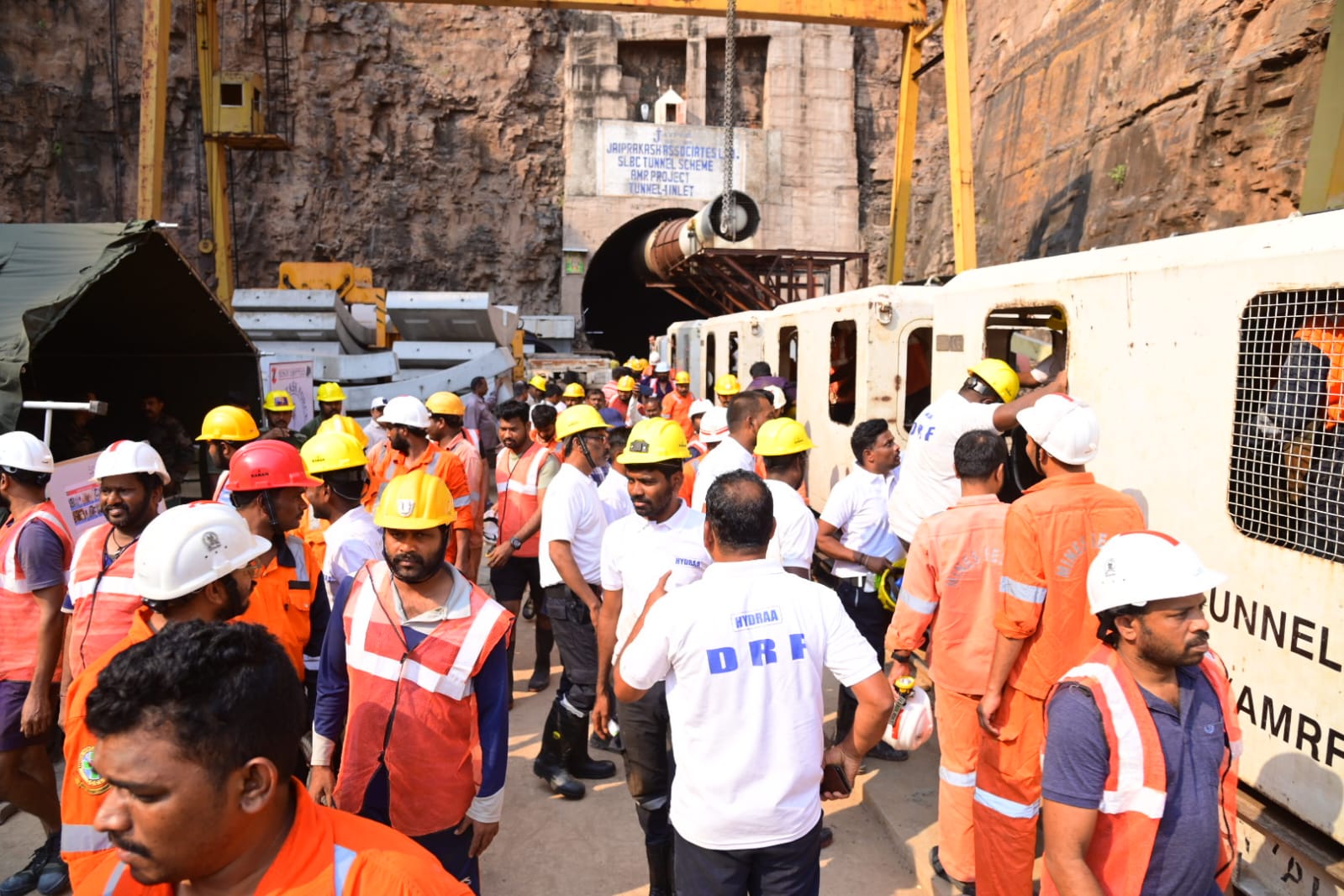The conveyor belt, crucial for transporting debris and excavation material, now extends almost to the tail end of the tunnel boring machine, spanning approximately 13.8 kilometers of the 13.9-km tunnel.
Published Mar 04, 2025 | 7:20 PM ⚊ Updated Mar 04, 2025 | 9:22 PM

Multiple teams are working around the clock to find the eight men trapped in the tunnel. (Supplied)
Synopsis: The broken conveyor belt was made operational on Tuesday, 11 days after the collapse. The restoration of the conveyor belt gave momentum to the operation to find the eight trapped men. Multiple teams are working around the clock to find the workers trapped in slush and debris.
The search for eight men trapped inside the under-construction Srisailam Left Bank Canal (SLBC) tunnel in Telangana’s Nagarkurnool district gained momentum on Tuesday, 4 March, with the restoration of the conveyor belt.
The conveyor belt, crucial for transporting debris and excavation material, now extends almost to the tail end of the tunnel boring machine (TBM), spanning approximately 13.8 kilometers of the 13.9-km tunnel.
A portion of the tunnel’s roof collapsed on the morning of 22 February, trapping eight workers. Though the search and rescue operation received a boost with the restoration of the conveyor belt, the whereabouts or the condition of the trapped men remained unknown.
Confirming the restoration of the conveyor belt, Nagarkurnool Superintendent of Police (SP) Vaibhav Gaikwad said it started operating since Tuesday morning.
“Railway plasma machines are also at work to remove mechanical debris, allowing excavators to proceed. The removal of mud and debris will now be expedited with excavators and conveyor belts. We are working in three shifts, involving personnel from Singareni Collieries, rat miners, NDRF, SDRF, Jaypee company officials, and other government and private agencies,” the officer said.
Rescue teams have been struggling for the past 11 days to clear the accumulated slush and metal debris, a challenge exacerbated by the non-functional conveyor belt. Until Tuesday, workers manually loaded debris into trolleys attached to locomotives, a slow and tedious process.
Chief Minister A Revanth Reddy, who visited the site on Sunday, directed officials to explore the possibility of robotic intervention to ensure the safety of rescuers. He reiterated his government’s commitment to accelerate rescue efforts and provide necessary support to the affected families.
The chief minister refused to make any statement on the condition of the trapped men without evidence.
Meanwhile, in a significant breakthrough, the South Central Railway’s mechanical engineering team dismantled the damaged Tunnel Boring Machine’s platform using three ultra-thermic cutters, facilitating faster metal removal. Smaller machines have been now deployed to clear debris near the TBM’s tail end.
The Ministry of Railways and the National Geophysical Research Institute (NGRI) were actively engaged in the rescue operations, deploying Ground Probing Radar (GPR) and other advanced techniques to identify potential voids within the debris.
However, excavation efforts on Monday, 3 March, failed to locate the survivors in areas previously marked by GPR. A search revealed only metallic objects. This led officials to conclude that complete debris removal was the only viable way to trace the missing workers, despite the risk of further collapse.
With debris blocking the tunnel from the 13.3 km mark to the collapse site, the excavation primarily focused on four key sections (A, B, C, and D) between 13.3 km and 13.45 km.
Rat miners and Singareni rescue teams were working continuously, but they have yet to locate the trapped workers. Clearing the TBM’s rear section has been accorded priority since it impeded further search.
Debris inside the tunnel, estimated to have piled up to a height of 3-6 meters, has made excavation increasingly difficult. However, with the expected full operationalisation of the conveyor belt by Wednesday, 5 March, clearing of debris would be expedited.
The absence of access points along the tunnel further hampered the rescue efforts. Unlike conventional long tunnels, which feature entry and exit points every five kilometers, the SLBC tunnel lacked such provisions due to its subterrain passage through the Amrabad Tiger Reserve.
The state government has requested the assistance of the National Centre for Seismology (NCS), and a four-member team was expected at the scene shortly. The NCS would conduct a seismological study to assess tunnel conditions and determine the extent of water saturation in the affected area.
Meanwhile, manual excavation continued at eight GPR-identified points.
The Telangana High Court, on Monday, disposed of a Public Interest Litigation (PIL) seeking expedited rescue efforts, acknowledging the government’s ongoing measures.
The National Union for Migrant Workers filed the PIL, seeking a court order urging authorities to ensure all possible steps to save the trapped workers.
The excavation was being carried out by US-based Robbins Inc., in collaboration with contractor Jaiprakash Associates.
The missing workers include two engineers, two machine operators, and four laborers. They have been identified as Sunny Singh, Gurpreet Singh (Robbins Inc.), and Manoj Kumar, Srinivas, Sandeep Sahu, Santosh Sahu, Anuj Sahu, and Jagath Khes (Jaiprakash Associates employees).
As rescue efforts entered a critical phase, authorities were determined to navigate the complex challenges posed by the collapse. With technological advancements, enhanced manpower, and round-the-clock operations, officials hoped to make a breakthrough in locating and retrieving the trapped workers soon.
The SLBC tunnel collapse has drawn renewed scrutiny on the long-delayed Alimineti Madhava Reddy Project (AMRP), originally conceived in 1983.
Designed to transport 30 TMC (thousand million cubic feet) of Krishna River water to drought-prone areas in the Nalgonda and Nagarkurnool districts, the 44-km-long tunnel project faced repeated geological hurdles, including fractured rock formations and groundwater saturation.
(Edited by Majnu Babu).
